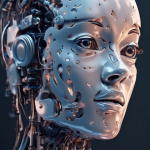The Role of AI Icons in Modern User Interface Design
The integration of AI icons in modern user interface design has revolutionized how users interact with digital products. These icons not only serve aesthetic purposes but also enhance functionality, creating seamless experiences that bridge technology and user needs. By leveraging artificial intelligence, designers can improve user engagement and accessibility, rendering interfaces more intuitive and visually appealing.
AI icons are designed using algorithms that analyze user behavior, preferences, and demographic data. This allows them to adapt to different contexts and user interactions. For instance, when users frequently utilize a specific feature, AI can promote that icon more prominently within the interface, making it easier to access. This dynamic approach facilitates a more personalized experience, which is increasingly crucial in today’s fast-paced digital landscape.
One of the key aspects that set AI icons apart is their ability to evolve. Unlike traditional static icons, AI-driven icons can change based on contextual feedback and user interaction patterns. They respond to user input in real-time, adapting their appearance or functionality to mirror the most relevant navigation pathways.
Moreover, AI icons support enhanced accessibility, ensuring that all users, regardless of their abilities, can navigate interfaces effortlessly. By incorporating AI, designers can create symbols that communicate meaning more effectively. For example, an AI icon can include auditory feedback or visual cues, making it easier for visually impaired users to interact with applications. In doing so, these icons play a vital role in creating inclusive digital environments.
Another significant benefit of AI icons is their ability to reduce cognitive load. In user interface design, it’s essential to minimize the effort users expend in processing information. Icons serve as visual shortcuts that can represent complex actions or data with a single glance. With AI icons, designers can analyze a user’s interaction history to streamline the interface, eliminating unnecessary features and focusing on the most frequently used functions. This increases usability and ensures a smooth navigation experience.
When it comes to aesthetic appeal, AI icons contribute to a contemporary, sleek design language. They can be crafted to match current design trends, ensuring that applications maintain a modern look and feel. The flexibility in design enables creators to experiment with various styles—from minimalistic to vibrant, enhancing user engagement through visual excitement.
In addition, AI icon design can employ techniques like **dynamic resizing** and **contextual relevance**. For example, based on screen size or user settings, AI icons can adjust their size without compromising clarity or detail. Contextually, an AI icon designed for a fitness app can appear differently when the user is interacting during a workout session versus when they are setting goals. Such adaptations boost the overall user experience and engagement levels.
Here are some critical elements enhancing the effectiveness of AI icons in interface design:
- Personalization: Adapting based on user preferences ensures relevant features are more accessible.
- Responsiveness: Icons that react to user behavior create a feeling of interaction and engagement.
- Accessibility: features for users with disabilities enhances inclusivity.
- Visual Clarity: Effective design minimizes confusion and aids quick comprehension.
- Trendy Aesthetics: Matching current design trends helps maintain user interest.
As technology advances, the integration of AI in interface design will likely grow. This shift not only addresses the present needs of users but anticipates future trends. Designers must remain agile, continuously evolving their strategies to leverage the full potential of AI icons.
In an era where user experience dictates the success of digital platforms, incorporating AI icons offers a compelling advantage. By focusing on user-centered design principles and leveraging the insights provided by artificial intelligence, designers can create interfaces that resonate with users, enhance functionality, and ensure satisfaction.
Ultimately, the role of AI icons is pivotal in the evolution of user interface design. They redefine how users interact with technology, making interfaces more accessible, intuitive, and enjoyable. As we look forward to what lies ahead, embracing these innovations provides a pathway toward creating interfaces that meet and anticipate user needs.
How AI Icons Enhance Brand Identity and User Engagement
In today’s digital landscape, businesses seek distinctive ways to capture their audience’s attention while establishing themselves as recognizable brands. One effective strategy that has emerged is the use of AI icons. These innovative visual elements can significantly enhance brand identity and boost user engagement.
AI icons encapsulate the essence of a brand in a simple yet engaging visual format. They generally utilize unique designs, colors, and shapes that resonate with the target audience. When executed well, AI icons can evoke emotions and convey messages far more effectively than text alone. This visual storytelling can lead to stronger brand loyalty and recall among users.
First, let’s explore the characteristics that make AI icons powerful tools for brand identity:
- Simplicity: Their minimalist approach allows users to grasp the brand’s message quickly.
- Versatility: AI icons can be adapted across various platforms, ensuring consistent branding.
- Memorability: A well-designed icon sticks in people’s minds, making it easier for them to remember your brand.
- Visual Appeal: Engaging visuals attract more attention, drawing users in and encouraging interaction.
Moreover, using AI icons in various contexts leads to improved user experiences. For instance, incorporating them into mobile applications or websites can help streamline navigation. Instead of scrolling through endless text, users can visually identify tools or resources they need at a glance, which encourages them to interact more deeply with the content.
Another area where AI icons excel is in enhancing the emotional connection between users and brands. By utilizing colors and shapes that evoke specific feelings, brands can effectively guide their audience’s emotional responses. For example, a tech company might utilize sleek, modern icons to convey innovation, while a wellness brand could use soft, rounded shapes to promote a sense of calm and comfort.
AI icons into branding strategies supports a cohesive identity that builds trust among users. An iconic symbol transcends language barriers and simplifies complex ideas into digestible visual cues. Consequently, companies can foster an international presence without losing the essence of their brand message.
To leverage AI icons effectively, brands should consider the following tactics:
- Consistency: Ensure that AI icon designs align with existing branding elements, including color palettes and typography.
- Contextual Use: Place icons strategically throughout various touchpoints, such as email campaigns, social media, and websites.
- User Feedback: Solicit insights from users about their experiences with the icons to refine and improve designs over time.
- Trend Awareness: Stay updated on design trends to keep icons relevant and appealing to the audience.
AI icons also play a crucial role in digital marketing. In a world where attention spans are shorter than ever, eye-catching visuals can act as a hook that draws users in. When used in advertisements, AI icons can succinctly communicate key messages, increasing click-through rates while enticing potential customers to explore more.
Furthermore, responsive design has become paramount, especially with varying screen sizes on mobile devices. Smartly designed AI icons maintain their functionality and aesthetics across platforms, ensuring a seamless user experience. This adaptability makes them essential in an era where mobile-first approaches dominate the market.
In terms of analytics, deploying AI icons can provide valuable data on user interaction. Companies can track which icons draw the most engagement, allowing for informed decisions when it comes to refining branding strategies. This data-driven approach enables businesses to remain agile and responsive to market demands.
Ultimately, the effective integration of AI icons into branding strategies serves to enhance brand identity and user engagement significantly. As businesses continue to navigate the complexities of a digital-first world, leveraging these visual tools will be instrumental in standing out and nurturing lasting connections with their audiences.
Conclusion
The journey through the landscape of AI icons in modern user interface design reveals a profound transformation that is redefining how users interact with digital platforms. As technology evolves, so does the expectation for interfaces to be more intuitive, visually appealing, and functional. AI icons play a pivotal role in shaping this experience. They are not just mere decorative elements; they encapsulate functionality and aesthetic appeal, leading users to navigate apps and websites more seamlessly.
Integrating AI icons into user interface design can significantly elevate the overall quality and efficiency of digital interactions. These icons provide clear, concise representations of actions and functions, making it easier for users to comprehend complex processes without the need for extensive text. This is particularly valuable in an age where digital literacy varies widely among users. By employing AI icons that convey meaning at a glance, designers can bridge the knowledge gap and create a more inclusive experience.
Moreover, the ability of AI icons to adapt to user preferences and behaviors cannot be overlooked. Using machine learning algorithms, AI icons can personalize the interface based on individual user patterns. This dynamic adaptation enables a fluid interaction model where users feel acknowledged and in control. As users engage with an interface that seems to understand them, they are more likely to stay longer, explore more features, and ultimately convert into loyal customers.
Brand identity is another critical aspect where AI icons prove their worth. A cohesive set of icons can reinforce a company’s brand ethos and unique selling proposition. Modern consumers are attracted to brands that convey authenticity and uniqueness, and AI icons can communicate these values visually. When an organization invests in a unique iconography that ties in with its overall aesthetic, it creates a memorable experience for users. Over time, these visual symbols become synonymous with the brand, enhancing recall and recognition in a crowded marketplace.
When brands utilize AI icons thoughtfully, they don’t just improve navigation; they also increase user engagement. Well-designed icons can compel users to take actions, leading to improved click-through rates and conversions. For example, a well-placed icon for a call-to-action can stimulate immediate responses, prompting users to subscribe, purchase, or engage further. In essence, these icons become not only points of interaction but catalysts for user journeys that drive business goals.
The integration of AI icons in UI/UX design also allows for a more engaging storytelling approach. By using icons that resonate with users on an emotional level, brands can enhance their narrative. Imagine a fitness brand using energetic, vibrant icons that reflect health and vitality in their app interface. This provides more than just functional benefit; it also aligns with the brand’s messaging and connects with the users’ goals and values.
Furthermore, updating and refining AI icon designs can revitalize existing products. As trends evolve and user preferences shift, revisiting iconography can inject new life into an interface. This not only keeps the product contemporary but also demonstrates a brand’s commitment to innovation and user-centered design.
AI icons also contributes significantly to accessibility. Well-thought-out icon designs can improve the experience for users with disabilities. By offering clear, recognizable symbols that can be easily differentiated, designers enhance usability for everyone.
From enhancing user interface design to building brand identity and increasing user engagement, the role of AI icons is multifaceted and impactful. As the digital landscape continues to evolve, embracing AI-driven iconography will likely prove to be an essential strategy for brands seeking to differentiate themselves.
Ultimately, the thoughtful application of AI icons represents a commitment to better design, deeper connections, and memorable user experiences. Brands that recognize this potential and leverage AI icons will not only enhance their existing interfaces but also establish themselves as leaders in innovation and user satisfaction in an ever-changing digital world. The future of user engagement lies in the effective marriage of technology and design, with AI icons standing at the forefront of this evolution.

